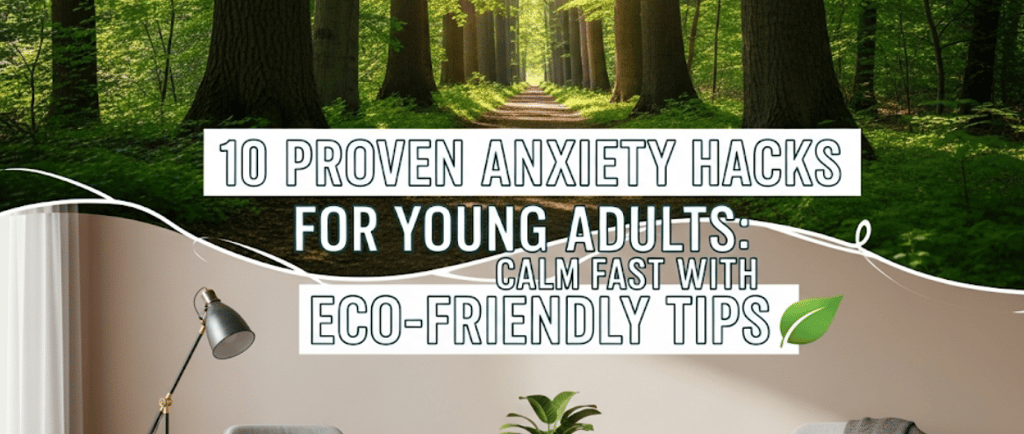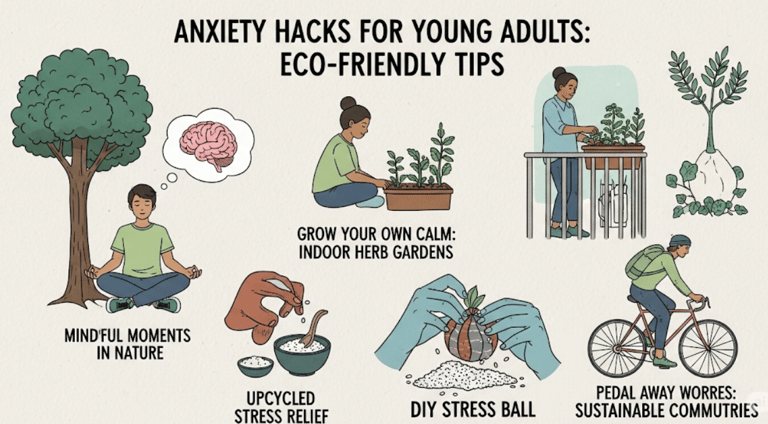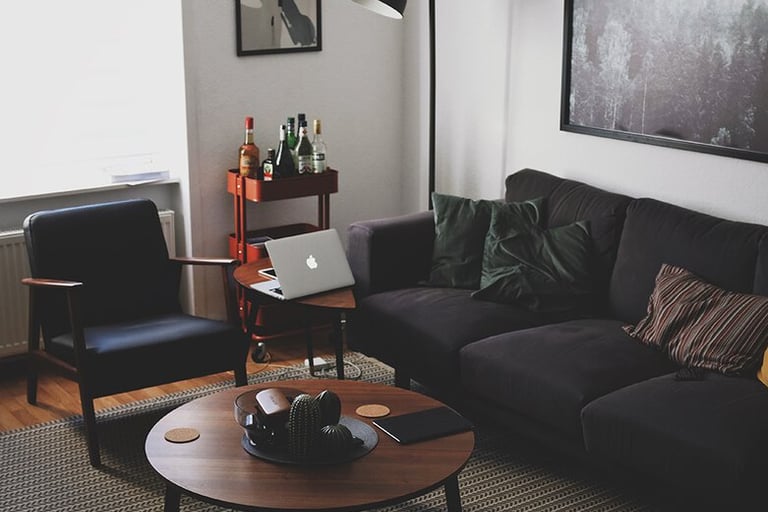10 Proven Anxiety Hacks for Young Adults: Calm Fast with Eco-Friendly Tips
Discover 10 proven eco-friendly anxiety hacks for young adults that cost nothing but deliver real results. From 4-7-8 breathing techniques to forest bathing and cold water therapy, learn natural ways to calm anxiety while protecting the planet. Simple, science-backed methods you can start today for lasting mental wellness.
VerdantEase
8/13/20259 min read


Being a young adult, in some ways, is like riding the world's roughest rollercoaster without an available seatbelt. From college stress, job hunting, relationships and figuring out who you are - anxiety is always around for the ride. The good news? With this 12-week program you can achieve these types of results without wasting your money on expensive therapy sessions, risky medications etc. Here are 10 Eco-Friendly Anxiety Hacks!
If you feel overwhelmed most of the day every day and want solutions that REALLY WORK and they must be SIMPLE & QUICK - this is for you. Drawing on ancient wisdom and modern science, these tried-and-tested approaches give you a natural way to build an arsenal of tools for anxiety that really work.
Here is Why Young Adults have More Anxiety Today
First, let us discuss how anxiety takes a toll on young adults before we get into the solutions. The comparison via social media, fear of climate change ending the world, economic uncertainty and pressure to have your life figured out by 25 all add up. Anxiety rates soar when you add environmental toxins, such as glyphosate, processed foods that contain excitotoxins and are nutritionally void, and we spend many hours indoors disconnected from nature.
Experimenting—instead of fighting your body's natural systems, you learn to work with them. Resetting for nature and with nature — you reset your nervous system to protect the environment you live in using eco-friendly methods referred to in this write up.
Hack #1: The 4-7-8 Breathing Reset
The ancient yoga tool — a breathing technique so powerful, your body cannot be in flight or fight response (aka anxious) while you are doing this exercise. Even better, it requires no tools and creates zero waste.
How to do it:
Exhale completely through your mouth
Breathe in through your nose for the count of 4
Hold your breath for 7 counts
Breathe out of your mouth for 8 counts
Repeat 3-4 cycles
How it works: This way of breathing helps the parasympathetic nervous system "wake up your calming," as research shows that it can reduce heart rate and blood pressure in minutes.
Pro tip: Practice twice a day (even if not anxious) to increase your stress resilience.
Hack #2: Build Yourself a Green Anxiety Sanctuary for Free!
The environment you surround yourself in reflects your mental state. Plants can even help to reduce anxiety in their environment—one study suggests that surrounding yourself with plants can minimize anxiety by as much as 37% based on research from the University of Technology Sydney.
Essential elements for your sanctuary:
Snake plant or Pothos (clean air while you sleep)
Aromatic plants (for example lavender or chamomile — natural aromatherapy)
Use of natural sunlight (no fluorescents)
Organic cotton cushions or blankets
Himalayan salt lamp with negative ions
Budget-friendly options:
Propagate plants from friends' cuttings
Use mason jars as planters
Make your own essential oil diffusers with bamboo reeds
Hack #3: The Benefits of Cold Water Therapy
Cold exposure has been used for thousands of years and is a FREE natural anti-anxiety agent. It causes the body to release norepinephrine, a chemical that may help your brain better cope with stress.
Easy ways to start:
End your shower with 30 seconds of cold water
Rinse face and wrists with cold water
Cold water body plunge
Try ice cubes on pressure points (temples, wrists, back of neck)
The science behind it: Cold exposure triggers your vagus nerve, which is responsible for regulating the body's relaxation response. Having regular cold treatment can help your brain process stress in a different way.
Quick safety note: Listen to your body and go slow. Consult your doctor first if you have heart conditions.
Hack #4: Stay At Home Forest Bathing
Learn more about the Japanese tradition of "shinrin-yoku" or forest bathing and science shows we should all be forest bathing to help with anxiety, cortisol levels, and immune function. Yet you do not need to reside near a wooded area.
Urban forest bathing techniques:
Play sounds: Use apps that include nature sounds or open windows to hear birds and wind
Let nature come inside: Find some sticks, rocks or shells and create a little corner of natural objects
Meditate with trees: Rest your back against any tree for about 10 minutes
Engage with natural textures: Barefoot walks over grass, sand or other natural materials
DIY nature immersion:
Brew herbal teas from wild plants (be sure they're safe and legal to pick)
Make art with found items from nature
Start a windowsill herb garden
Practice cloud watching or stargazing
Hack #5: The Anti-Anxiety Power Plate
Your diet directly affects how you feel. These cost-effective, bulk-packaged or homegrown anxiety-fighting foods do as well if not better than their processed alternatives!
Top Anxiety-Fighting Foods:
Food
Why it works
How to use
Dark leafy greens
Magnesium-rich (aka nature's chill pill)
Add to smoothies, salads, or sauté with garlic
Fatty fish
Omega-3s reduce inflammation and anxiety
Canned sardines or mackerel are budget-friendly
Fermented foods
Support gut health (90% of serotonin is made in your gut)
Homemade sauerkraut, kimchi, or kefir
Chamomile tea
Contains apigenin, a natural anxiety reducer
Drink 2-3 cups daily or grow your own chamomile
Dark chocolate
Increases mood-boosting chemicals
Choose 70%+ cacao; eat mindfully
Foods to avoid:
Too much caffeine (more than 2 cups of coffee a day)
Processed sugar and artificial sweeteners
Alcohol (it sabotages sleep and increases anxiety rebound)
High-ingredient processed foods
Hack #6: Free Movement Medicine
For mild to moderate anxiety, exercise has the same potential as medications — and you don't need a gym membership or fancy equipment. These environmentally positive movement practices involve body weight and use of natural surroundings.
Anxiety-busting movement options:
Walking meditation in nature
Walk slowly and be mindful of each step you take
Focus on your breathing
Engage your senses (sight, feel, hear)
Bodyweight yoga flow
Child's pose to Downward Dog to Cobra
Hold each stretch for 5-8 breaths
Finish with legs up the wall pose
Dancing to natural rhythms
Play music and dance in your room for 10 minutes
Join drum circles or dancing in the park
Dance barefoot on natural surfaces
Swimming in natural water
Lakes, rivers, or ocean swimming
Cold water can further reduce anxiety levels
Swim with others and stay safe
Hack #7: Sleep Sanctuary Setup
If you are losing sleep, that anxiety becomes increasingly more difficult to manage, which creates a vicious cycle. Building an environmentally friendly sleep sanctuary can help solve this without breaking the bank.
Natural sleep optimization:
Temperature control:
Keep bedroom between 65-68°F (18-20°C)
Natural fiber bedding (organic cotton, bamboo, linen)
Keep windows open for proper air circulation
Light management:
Get blackout curtains or use an eye mask
No screens 1 hour before bed
Use candlelight or salt lamps in the evening
Sound and scent:
White noise from fan + nature sounds
Lavender essential oil or dried herbs in pillowcases
No electronics in the room
Pre-sleep ritual:
Herbal tea (chamomile, passionflower, or valerian)
Gentle stretching or restorative yoga
Write down 3 gratitudes
Progressive muscle relaxation from toes to head


Hack #8: Digital Detox Strategies
Social media comparisons, information overload and poor sleep are encouraged by an obsessive culture of constant connection. Healthy digital boundaries are as necessary as the air we breathe for our mental wellness.
Daily boundaries:
No phones for the first hour in the morning
Set specific times for checking messages
Use "do not disturb" modes liberally
Create phone-free zones such as bedroom or dining room
Weekly digital sabbath:
Choose one day of the week to minimize devices
Replace screen time with time in nature, reading, or conversation
Buy an actual alarm clock
Social media audit:
Unfollow accounts that trigger comparison and negativity
Follow accounts that promote nature, mindfulness, or positivity
Track and limit social media use with apps
Engage your mind instead of mindlessly scrolling
Hack #9: The Grounding Connection
Earthing, or grounding, involves direct skin connection with the earth's surface. It has been proven that, by balancing your body's electrical charge, walking or sitting barefoot in the grass can reduce inflammation, boost sleep, and reduce anxiety.
Simple grounding practices:
Walk barefoot on grass, sand, or dirt for 15-30 minutes daily
Lie on natural outdoor surfaces while reading
Garden with bare hands in the ground
Swim in natural water bodies
Lean against trees while meditating
Indoor grounding:
Use grounding mats made of conductive materials
Take baths with unprocessed sea salt
Hold natural stones while meditating
Do yoga on natural fiber grass mats
Grounding is known to neutralize free radicals, lowering chronic inflammation that is closely linked with diseases such as anxiety and depression—giving your nervous system a reset button.
Hack #10: Community and Connection
As social beings, loneliness can boost anxiety. Building real connections while supporting the planet has a twofold benefit on yourself and the earth.
Eco-friendly community building:
Join environmental groups
Participate in gardening activities
Join hiking groups
Follow sustainability guidelines
Create connection opportunities:
Host plant swap parties with neighbors
Organize "green" potlucks
Start park walking clubs
Join zero-waste lifestyle communities
Participate in community environmental groups
Practice eco-volunteering:
Tree planting events
Beach or park cleanups
Wildlife conservation projects
Community composting programs
Benefits of eco-community involvement:
Purpose: Working for environmental causes brings meaning to life
Community: Surround yourself with like-minded people
Movement: Many environmental activities include physical activity
Nature: Most eco-volunteering happens outdoors
Stress relief: Reducing your carbon footprint while helping others means less stress on yourself
Quick Reference: Emergency Anxiety Kit
When anxiety strikes, fast-acting tools are a necessity. Keep these eco-friendly items accessible:
Physical items:
Small bottle of lavender essential oil
Smooth stone for tactile grounding
Herbal tea sachets (chamomile, passionflower or lemon balm)
Printed list of your favorite grounding techniques
Mental techniques:
4-7-8 breathing pattern
5-4-3-2-1 grounding technique (identify 5 things you can see, 4 things you can hear, 3 you can touch, 2 things you can smell and 1 thing you can taste)
Progressive muscle relaxation
Weekly positive affirmations written in your own handwriting
Creating Lasting Habits: The Key to Long-term Anxiety Relief
Pick one or two methods that resonate with you and practice them daily for 14 days, then slowly add more practices.
Habit stacking strategy: Associate new anxiety-relief routines with existing habits:
Example: "I will practice 4-7-8 breathing after brushing my teeth"
Example: "I will write three gratitudes before I pick up my phone"
Track your progress:
Use a simple journal or phone app to record anxiety levels (1-10)
Note which methods you used and how well they worked
Recognize your triggers and patterns
Celebrate small wins:
Acknowledge each time you use a healthy coping strategy
Share your progress with a supportive friend or family member
Reward consistent practice with nature-related treats (new plant, hiking gear, etc.)
Your Healing Matters for the Planet — The Ripple Effect
Each time you choose to support your mental health in an environmentally friendly way, it creates ripples. Every time you select natural anxiety remedies instead of pharmaceutical solutions, eat local organic food instead of processed food, take a walk in nature instead of staying indoors, and connect with your neighbors at community events or volunteer locally - you are voting for creating a healthier world.
Young adults like you are already at the forefront of shifting habits towards a more sustainable lifestyle. By combining anxiety management with eco-conscious behavior, you are demonstrating a new way of living that promotes wellness for yourself as well as the planet.
Take Action for Calmer Living
If you haven't tried any of the techniques listed above, make a promise to yourself that starting today you will implement one new technique and see how it works in your daily life. Whether it's the 4-7-8 breathing, building a plant-filled sanctuary in your home, or joining an environmental group - just get started.
Remember, anxiety management is a journey, not a destination. Be patient with yourself and know that some days will be easier than others. The skills you gain here are not just for dealing with crisis situations; these tools can be the building blocks of a lifestyle designed for resilience and well-being.
You matter, and so does your planetary home. When you choose green anxiety methods, you care for both your wellbeing and the environment for future generations. This gives you something to be proud of—and perhaps a little less anxious about too.
Peace doesn't have to break the bank. It simply takes courage to try, compassion with yourself as you learn, and understanding that healing happens one breath, step and moment at a time.
Frequently Asked Questions
Q: How quickly do these natural anxiety hacks take effect? A: Some techniques like 4-7-8 breathing and cold water therapy will make a difference within minutes, while others might need you to practice them for 2-4 weeks consistently as a daily routine (like plant therapy or dietary changes). The key is a blend of immediate relief tools and long-term lifestyle changes.
Q: Do these natural techniques replace anxiety medication? A: These techniques can be incredibly helpful for many people, but should not replace professional medical care. If you are currently taking anxiety medication, speak with your healthcare provider before making any changes.
Q: What if I live in a city with very little access to nature? A: Urban areas can still provide green benefits through indoor plants, urban rooftop gardens, city parks, cold water therapy, and connecting with local environmental groups. Even a little bit of green space can have a noticeable benefit for mental health.
Q: Are there any side effects to these natural anxiety remedies? A: These methods are generally safe for most people. However, if you have heart conditions, start cold water therapy slowly, and be careful about which herbs you use if you have allergies or are on medication. Listen to your body, and consult with a medical professional if you have concerns.
Q: How expensive are these anxiety hacks? A: Most of these techniques are free (breathwork, grounding practices, movement). The most expensive items might be organic foods or plants, but you can start seeds very cheaply. Focus on one method at a time to spread costs over time.
Q: Will these methods work for severe anxiety or panic attacks? A: While these techniques can help manage general anxiety and mild panic symptoms, severe anxiety disorders require professional treatment. They are most effective as part of a comprehensive approach to anxiety, including therapy, medication, and lifestyle changes under professional guidance.
Q: How can I know which technique will work best for me? A: Different people respond differently to anxiety management techniques. Start with the methods that sound most appealing or accessible to you, try each for at least a week, and keep track of what helps the most. You may find that you prefer breathing techniques for immediate relief, plants for daily calm, and movement for long-term resilience.


